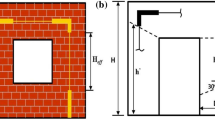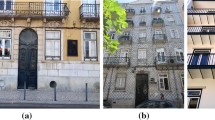Abstract
Despite the fact that in recent years Portugal has not seen the occurrence of high-magnitude earthquakes, it remains threatened by these events due to its geographic location. Since the 1960s, reinforced concrete has been the most used material for new constructions; however, the historic urban centers are dominated by old unreinforced masonry (URM) buildings, which techniques and construction materials have evolved since the Great Lisbon earthquake that occurred in 1755 (Mw = 8.5). Given the presence of these buildings in areas of significant seismicity, extensive research is needed to assess the seismic risk and define mitigation policies. This kind of studies is often supported by empirical methods and based on expert judgment due to the high variability of the building stock and lack of information. The main purpose of this work is: (i) to provide analytical fragility curves, supported by nonlinear static analysis, for the entire population of old masonry buildings, built before the introduction of the first design code for building safety against earthquakes (RSSCS) in 1958; (ii) define vulnerability curves to be used by the technical community for seismic assessment of pre code URM buildings. The characterization of the building stock geometry and material properties is based on information previously collected, which was essential to define representative archetypes and typologies.



















Similar content being viewed by others
Notes
Set of vertical long boards connected by horizontal small wood stripes, normally filed with pieces of bricks and lime mortar.
Set of plane wood trusses very common in “Pombalino” typology.
References
Asteris PG, Chronopoulos MP, Chrysostomou CZ, Varum H, Plevris V, Kyriakides N, Silva V (2014) Seismic vulnerability assessment of historical masonry structural systems. Eng Struct. https://doi.org/10.1016/j.engstruct.2014.01.031
Azizi-Bondarabadi H, Mendes N, Lourenço PB, Sadeghi NH (2016) Empirical seismic vulnerability analysis for masonry buildings based on school buildings survey in Iran. Bull Earthq Eng. https://doi.org/10.1007/s10518-016-9944-1
Bernardo V, Campos Costa A, Candeias P, Costa A, Marques A, Carvalho A (2022) Ambient vibration testing and seismic fragility analysis of masonry building aggregates. Bull Earthq Eng. https://doi.org/10.1007/s10518-022-01387-y
Bernardo V, Krejčí T, Koudelka T, Šejnoha M (2020) Homogenization of unreinforced old masonry wall comparison of scalar isotropic and orthotropic damage models. Acta Polytech CTU Proc 26:1–6
Bernardo V, Sousa R, Candeias P, Costa A, Campos Costa A (2021) Historic appraisal review and geometric characterization of old masonry buildings in lisbon for seismic risk assessment. Int J Archit Herit. https://doi.org/10.1080/15583058.2021.1918287
Candeias P (2008) Avaliação da vulnerabilidade sísmica de edifícios de alvenaria (PhD Thesis). University of Minho, Minho, Portugal [in Portuguese]
Candeias P, Correia A, Costa AC, Catarino JM, Pipa M, Cruz H, Carvalho E, Costa A (2020) General aspects of the application in Portugal of Eurocode 8 – Part 3 – Annex C (Informative) – Masonry Buildings [in Portuguese]. Revista Portuguesa de Engenharia de Estruturas. Ed. LNEC. Série III. n.° 12. ISSN 2183-8488. (março 2020) 99–120, Portugal [in Portuguese]
CEN (2004) Eurocode 8: Design of structures for earthquake resistance - Part 1: General rules, seismic actions and rules for buildings. Comite Europeen de Normalisation, Brussels, Belgium
Ceran HB, Erberik MA (2013) Effect of out-of-plane behavior on seismic fragility of masonry buildings in Turkey. Bull Earthq Eng. https://doi.org/10.1007/s10518-013-9449-0
Colombi M, Borzi B, Crowley H, Onida M, Meroni F, Pinho R (2008) Deriving vulnerability curves using Italian earthquake damage data. Bull Earthq Eng. https://doi.org/10.1007/s10518-008-9073-6
Correia MR, Lourenço PB, Varum H (2015) Seismic retrofitting: Learning from vernacular architecture. Taylor & Francis. 1st edition. ISBN 9781138028920
Costa AA (2012) Seismic assessment of the out‐of‐plane performance of traditional stone masonry walls (PhD Thesis). Faculty of Engineering, University of Porto. FEUP
D’Ayala D (2005) Force and displacement based vulnerability assessment for traditional buildings. Bull Earthq Eng. https://doi.org/10.1007/s10518-005-1239-x
Del Gaudio C, De Martino G, Di Ludovico M, Manfredi G, Prota A, Ricci P, Verderame GM (2017) Empirical fragility curves from damage data on RC buildings after the 2009 L’Aquila earthquake. Bull Earthq Eng. https://doi.org/10.1007/s10518-016-0026-1
Delgado J (2013) Avaliação sísmica de um edifício crítico em alvenaria (MSc Thesis). NOVA University of Lisbon, Lisbon, Portugal [in Portuguese]
Domingos C (2010) Caracterização de edifícios antigos: edifícios pré-pombalinos (MSc Thesis). Technical University of Lisbon, Lisbon, Portugal [in Portuguese]
Douglas J, Seyedi DM, Ulrich T, Modaressi H, Foerster E, Pitilakis K, Pitilakis D, Karatzetzou A et al (2015) Evaluation of seismic hazard for the assessment of historical elements at risk: description of input and selection of intensity measures. Bull Earthq Eng. https://doi.org/10.1007/s10518-014-9606-0
EN1998-3:2017 N Eurocódigo 8 – Projeto de Estruturas para Resistência aos Sismos – Parte 3: Avaliação e Reabilitação de Edifícios.
Ferreira TM, Costa AA, Vicente R, Varum H (2015) A simplified four-branch model for the analytical study of the out-of-plane performance of regular stone URM walls. Eng Struct. https://doi.org/10.1016/j.engstruct.2014.10.048
Ferreira TM, Vicente R, Mendes da Silva JAR, Varum H, Costa A (2013) Seismic vulnerability assessment of historical urban centres: case study of the old city centre in Seixal, Portugal. Bull Earthq Eng 11:1753–1773. https://doi.org/10.1007/s10518-013-9447-2
Ferrito T, Milosevic J, Bento R (2016) Seismic vulnerability assessment of a “placa” building aggregate by linear and nonlinear analysis. Bull Earthq Eng. https://doi.org/10.1007/s10518-016-9900-0
Frankie TM, Gencturk B, Elnashai AS (2013) Simulation-based fragility relationships for unreinforced masonry buildings. J Struct Eng. https://doi.org/10.1061/(asce)st.1943-541x.0000648
Frazão M (2013) Modelação de um edifício “ Gaioleiro ” para Avaliação e Reforço Sísmico (MSc Thesis). Technical University of Lisbon, Lisbon, Portugal [in Portuguese], 2019
Fryer MJ, Rubinstein RY (1983) Simulation and the Monte Carlo Method. J Royal Stat Soc Ser A (general). https://doi.org/10.2307/2981504
Galasco A, Lagomarsino S, Penna A (2006) On the use of pushover analysis for existing masonry buildings. First European Conference on Earthquake Engineering and Seismology 3–8
Giordano N, De Luca F, Sextos A (2021) Analytical fragility curves for masonry school building portfolios in Nepal. Bull Earthq Eng. https://doi.org/10.1007/s10518-020-00989-8
INE (2012) Censos 2011 Resultados Definitivos. Report. Lisbon, Portugal [in Portuguese]
Jaimes MA, Chávez MM, Peña F, García-Soto AD (2021) Out-of-plane mechanism in the seismic risk of masonry façades. Bull Earthq Eng. https://doi.org/10.1007/s10518-020-01029-1
Kappos AJ, Panagopoulos G, Panagiotopoulos C, Penelis G (2006) A hybrid method for the vulnerability assessment of R/C and URM buildings. Bull Earthq Eng. https://doi.org/10.1007/s10518-006-9023-0
Kappos AJ, Papanikolaou VK (2016) Nonlinear dynamic analysis of masonry buildings and definition of seismic damage states. Open Constr Build Tech J. https://doi.org/10.2174/1874836801610010192
Lagomarsino S, Cattari S (2014) Fragility Functions of Masonry Buildings. Geotech Geol Earthq Eng. https://doi.org/10.1007/978-94-007-7872-6_5
Lagomarsino S, Cattari S (2015) Seismic performance of historical masonry structures through pushover and nonlinear dynamic analyses. Geotech Geol Earthq Eng. https://doi.org/10.1007/978-3-319-16964-4_11
Lagomarsino S, Cattari S, Ottonelli D (2021) The heuristic vulnerability model: fragility curves for masonry buildings. Bull Earthq Eng. https://doi.org/10.1007/s10518-021-01063-7
Lagomarsino S, Penna A, Galasco A, Cattari S (2013) TREMURI program: An equivalent frame model for the nonlinear seismic analysis of masonry buildings. Eng Struct. https://doi.org/10.1016/j.engstruct.2013.08.002
Lamego P (2014) Reforço sísmico de edifícios de habitação. Viabilidade da mitigação do risco. (PhD thesis). Universidade do Minho [in Portuguese]
Lopes M, Meireles H, Cattari S, Bento R, Lagomarsino S (2014) Building Pathology and Rehabilitaion. In: Costa A, Guedes JM, Varum H (eds) Structural Rehabilitation of Old Buildings. Springer-Verlag, pp 187–234
Maio R, Vicente R, Formisano A, Varum H (2015) Seismic vulnerability of building aggregates through hybrid and indirect assessment techniques. Bull Earthq Eng. https://doi.org/10.1007/s10518-015-9747-9
Marques A (2020) Reabilitação de Edifícios Antigos: Redução da Vulnerabilidade Sísmica Através do Reforço de Paredes (PhD Thesis). Technical University of Lisbon, Lisbon, Portugal [in Portuguese]
Meireles HA, Bento R (2012) Seismic assessment and retrofitting of Pombalino buildings by fragility curves. In: 15th World Conference on Earthquake Engineering, Lisbon Portugal
Mendes N (2012) Seismic assessment of ancient masonry buildings: shaking table tests and numerical analysis (PhD Thesis). University of Minho, Minho, Portugal
Milosevic J (2019) Seismic vulnerability assessment of mixed masonry-reinforced concrete buildings in Lisbon (PhD Thesis). Technical University of Lisbon
Milosevic J, Cattari S, Bento R (2020) Definition of fragility curves through nonlinear static analyses: procedure and application to a mixed masonry-RC building stock. Bull Earthq Eng. https://doi.org/10.1007/s10518-019-00694-1
Miranda L (2011) Ensaios acústicos e de macacos planos em alvenarias resistentes. PhD Thesis. Faculty of Engineering, University of Porto
Monteiro M, Bento R (2012) Characterization of ‘Placa’ buildings, Report ICIST, DTC no 02/2012. Technical University of Lisbon, Lisbon, Portugal ([in Portuguese])
Moré JJ (1978) The Levenberg-Marquardt algorithm: Implementation and theory. In: Numerical Analysis, ed. G. A. Watson, Lecture Notes in Mathematics 630, Springer Verlag, 1977, pp. 105–116
Oliveira CS (1986) A sismicidade historica e a revisao do catalogo sismico. National Laboratory for Civil Engineering. Report 36/11/7368
Penna A, Lagomarsino S, Galasco A (2014) A nonlinear macroelement model for the seismic analysis of masonry buildings. Earthq Eng Struct Dynam 43:159–179. https://doi.org/10.1002/eqe
Pinho FFS (2000) Paredes de Edifícios Antigos em Portugal (PhD Thesis). NOVA University of Lisbon, Lisbon, Portugal [in Portuguese]
Pitilakis K, Crowley H, Kaynia AM (2014) SYNER-G: typology definition and fragility functions for physical elements at seismic risk: buildings lifelines transportation networks and critical facilities. Geotech Geol Earthq Eng. https://doi.org/10.1007/978-94-007-7872-6
Porter K, Kennedy R, Bachman R (2007) Creating fragility functions for performance-based earthquake engineering. Earthquake Spectra Doi 10(1193/1):2720892
Rosti A, Del Gaudio C, Rota M, Ricci P, Di Ludovico M, Penna A, Verderame GM (2021) Empirical fragility curves for Italian residential RC buildings. Bull Earthq Eng. https://doi.org/10.1007/s10518-020-00971-4
Rota M, Penna A, Magenes G (2010) A methodology for deriving analytical fragility curves for masonry buildings based on stochastic nonlinear analyses. Eng Struct. https://doi.org/10.1016/j.engstruct.2010.01.009
RSCCS (1958) National Standard: Code for Building Safety Against Earthquakes (Original Title: Regulamento de Segurança das Construções contra os Sismos – RSCCS)
Sandoli A, Lignola GP, Calderoni B, Prota A (2021) Fragility curves for Italian URM buildings based on a hybrid method. Bull Earthq Eng. https://doi.org/10.1007/s10518-021-01155-4
Silva V, Crowley H, Varum H, Pinho R (2014) Seismic risk assessment for mainland Portugal. Bull Earthq Eng. https://doi.org/10.1007/s10518-014-9630-0
Simões A, Bento R, Gago A, Lopes M (2015) Mechanical characterization of masonry walls with flat-jack tests. Exp Tech. https://doi.org/10.1111/ext.12133
Simöes AG, Bento R, Lagomarsino S, Cattari S, Louren o PB (2018) The seismic assessment of masonry buildings between the 19th and 20th centuries in lisbon-evaluation of uncertainties. In: Proceedings of the International Masonry Society Conferences
Simões AG, Bento R, Lagomarsino S, Cattari S, Lourenço PB (2020) Seismic assessment of nineteenth and twentieth centuries URM buildings in Lisbon: structural features and derivation of fragility curves. Bull Earthq Eng. https://doi.org/10.1007/s10518-019-00618-z
Simões AGG (2018) Evaluation of the seismic vulnerability of the unreinforced masonry buildings constructed in the transition between the 19th and 20th centuries in Lisbon (PhD Thesis). Technical University of Lisbon, Lisbon, Portugal [in Portuguese], 2019
Sousa ML (2006) Seismic risk in Mainland Portugal (PhD Thesis). Technical University of Lisbon, Lisbon, Portugal [in Portuguese]
Sumerente G, Lovon H, Tarque N, Chácara C (2020) Assessment of combined in-plane and out-of-plane fragility functions for adobe masonry buildings in the peruvian andes. Front Built Environ. https://doi.org/10.3389/fbuil.2020.00052
Vamvatsikos D, Cornell CA (2002) Incremental dynamic analysis. Earthquake Eng Struct Dynam. https://doi.org/10.1002/eqe.141
Vicente R (2008) Estratégias e metodologias para intervenções de reabilitação urbana Avaliação da vulnerabilidade e do risco sísmico do edificado da Baixa de Coimbra. University of Aveiro, Aveiro, Portugal ([in Portuguese])
Vicente R, Ferreira T, Maio R (2014) Seismic risk at the urban scale: assessment, mapping and planning. Proced Econ Financ. https://doi.org/10.1016/s2212-5671(14)00915-0
Vicente R, Parodi S, Lagomarsino S, Varum H, Silva J (2011) Seismic vulnerability and risk assessment: Case study of the historic city centre of Coimbra. Bulletin of Earthquake Engineering, Portugal. https://doi.org/10.1007/s10518-010-9233-3
Funding
This work was supported by the Foundation for Science and Technology (FCT) under Grant number PD/BD/135325/2017 in the scope of the InfraRisk Doctoral Programme—Analysis and Mitigation of Risks in Infrastructures.
Author information
Authors and Affiliations
Corresponding author
Ethics declarations
Conflicts of interest
No potential conflict of interest was reported by the authors.
Additional information
Publisher's Note
Springer Nature remains neutral with regard to jurisdictional claims in published maps and institutional affiliations.
Rights and permissions
About this article
Cite this article
Bernardo, V., Campos Costa, A., Candeias, P. et al. Seismic vulnerability assessment and fragility analysis of pre-code masonry buildings in Portugal. Bull Earthquake Eng 20, 6229–6265 (2022). https://doi.org/10.1007/s10518-022-01434-8
Received:
Accepted:
Published:
Issue Date:
DOI: https://doi.org/10.1007/s10518-022-01434-8




